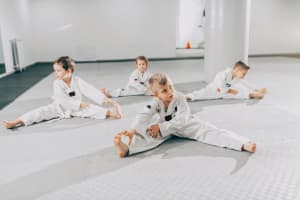
Many martial arts practitioners began taking martial arts classes at an early age. Maybe their parents thought they needed the discipline, or maybe the child wanted to try an extracurricular activity. No matter the reason, martial arts is a great after-school activity for children. However, since so many people begin martial arts at such a young age, many people are under the impression that they may be too old to begin practicing the craft. That couldn’t be further from the truth! Here’s what you should know about beginning martial arts at any age:
IT’S NEVER TOO LATE
Healthy Women guest blogger Natasha Spearman-Isip wrote, “Midlife martial arts? I can wholeheartedly recommend it!” She goes on to tell the story of taking her 10-year-old twins to karate class and deciding to take a taiji class herself. In addition to the fitness benefits of the class, she was also pleased to learn more about meditation. Her story is similar to many people who begin taking martial arts courses later in life.
According to The Wall Street Journal, there are approximately 30,000 martial arts schools in the country, and many of them have classes specifically tailored to older students. Many of these older students, who may have begun taking classes as a hobby, are even reaching black belt status.
“I feel like a million bucks,” 71-year old Steven Tsapos told The Wall Street Journal. “For older people I think it’s the best exercise there is.”
Tsapos takes tae kwon do four times a week. In his class, there are some adjustments taken into account when older students spar with younger ones. For example, there isn’t much force exerted in the punches and kicks.
HOW TO FIND A CLASS
Like with any sort of fitness class, it’s a good idea to visit a variety of studios before committing to a martial arts class. Many studios offer one-time classes at a discounted rate, so prospective students can get a feel for what the atmosphere is like. Some are more serious, for students who are training to compete. Others are more laid back and tailored for students looking to just have some fun and get in shape. Many classes fall somewhere in between.
A few things to keep in mind, aside from the atmosphere and attitude of the studio, include your reasons for going and your budget. Some martial arts classes focus heavily on the self-defense aspect, while others place more of an emphasis on the spiritual aspect. Know what’s most important to you before you commit to a school, and be sure your school of choice reflects that. Know how much you want to spend on your training, as well, as some courses are much pricier than others. Find out what comes with your enrollment fees.
LEARN THE ROPES
Martial arts schools, or dojos, have vibes all of their own. It’s important to learn the ins and outs of your particular school. Bowing is a staple in the martial arts community. It’s a sign of mutual respect. While just about every spar begins with a bow, in some of the more traditional schools, people bow as they enter or exit the building. You’ll begin to catch on as you observe your surroundings. When beginning a class, err on the side of formality and address your instructor as “sir,” “ma’am” or “sensei” as well. Respect is an important tenet of martial arts, so you should exercise it at all times.

